Spring Summer Fall Winter and Spring Again Einstein Notion of Time
Kim Ki-duk, Bound, Summer, Autumn, Winter … and Spring
A human being for all seasons
The Bodhisattva of Compassion,
When he meditated deeply,
Saw the emptiness of all five skandhas
And sundered the bonds that caused him suffering.
—The Heart Sutra
IN A Earth obsessed with finding significance and validation through being a somebody,Leap, Summertime, Autumn, Winter … and Jump tells the story of a lone monk who has found significant through forsaking the secular realm and diving deep into the very depths of his ain soul. And yet, despite his secluded existence, the outside earth inevitably comes calling, reminding us that disengagement can merely ever truly be a state of listen and disposition of eye.
Written and directed by Korean auteur, Kim Ki-duk'southward exquisitely beautiful masterpiece filmed at Jusan Pond in North Gyeongsang Province in Southward Korea portrays the subsequent relationship between a Buddhist renunciate and his young protégé, characters whose names are never relayed. Yet, despite the film's absence of whatever specific temporal referencing,Spring, Summer, Autumn, Wintertime … and Spring is a deeply sophisticated meditation on the vagaries of the human condition reflected within the passing seasons of nature.
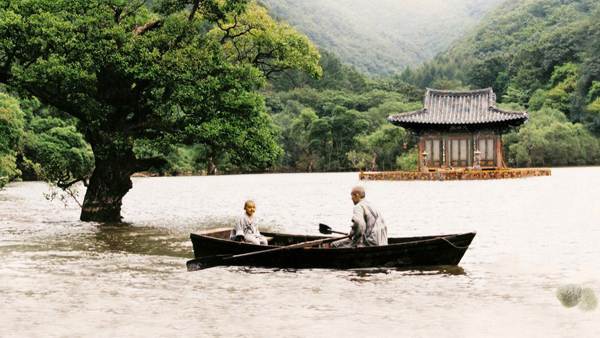
Bound, Summer, Autumn, Winter … and Bound.
Photo: © Sony Pictures Classics
Hither then,
Course is no other than emptiness,
Emptiness no other than grade.
Course is merely emptiness,
Emptiness but form.
—The Heart Sutra
Akin to Michelangelo Frammartino's Le Quattro Volte, which explores like themes associated with the transience of life set against a backdrop of the natural landscape, the stunning alpine topography forms an integral chemical element to this elegiac drama, with each of the 5 titular segments representing a stage in a man's life and the associated lessons he must larn.
Despite the minimal use of dialogue, through the use of Buddhist iconography and Aesopian symbols, nosotros get acutely enlightened of the inherent bulletin of the ancient nondual teachings embodied in the doctrine of the 3 Universal Truths—annica (impermanence), dukka (suffering) and anatta (no self)—as they unfold throughout the movie, with the principles of the 4 Noble Truths—the causes and abeyance of suffering—forming the didactical framework through which the plot evolves.
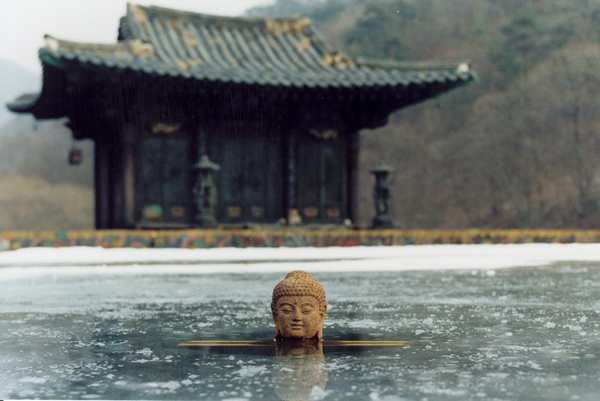
Bound, Summer, Autumn, Winter … and Spring
Photograph: © Sony Pictures Classics
Moreover, in a film steeped in visual imagery, the lake itself functions as a metaphor for universal mind, its silent waters the very embodiment of the enlightenment land, with the floating hermitage representative peradventure of the fragile self, globe-trotting silently atop its omnipresent depths.
Similarly, the monastery's humble rowboat is symbolic of the individual's journeying on the spiritual path. Beautifully painted with images of Guan Yin (the bodhisattva of compassion and mercy) as she extends a hand that holds the lotus-born child, Maitreya, the future Buddha, it is the yana or vehicle by which the young monk is transported to his spiritual destiny, across the bounding main of samsara to the mountain shore of liberation and release.
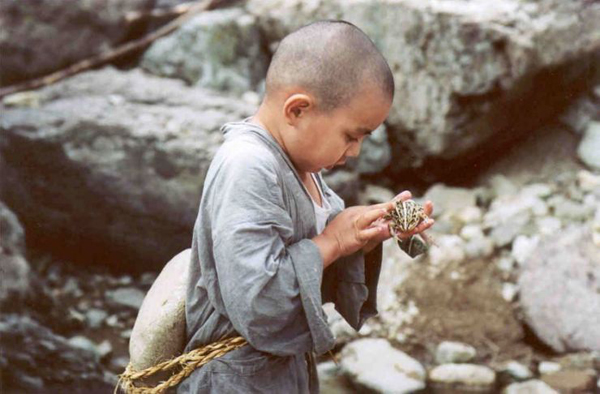
Spring, Summertime, Fall, Wintertime … and Spring.
Photograph: © Sony Pictures Classics
Feeling, thought and choice,
Consciousness itself,
Are the same as this.
All things are by nature void
They are non born or destroyed
Nor are they stained or pure
Nor do they wax or wane.
—The Centre Sutra
And thus information technology is springtime. In the mode of a dramatized Eastern fable, the film commences with ii wooden carved doors of a "gateless gate" creaking open to reveal a mysterious monastery globe-trotting upon the serene surface of a swimming, whose sole occupants are an old monk (Oh Young-soo) and his child disciple (Kim Jong-ho). Life is quiet and uncomplicated and like any young boy, the master'southward educatee enjoys playing with his puppy and collecting herbs until one twenty-four hours, he is consumed by the capricious cruelties of babyhood.
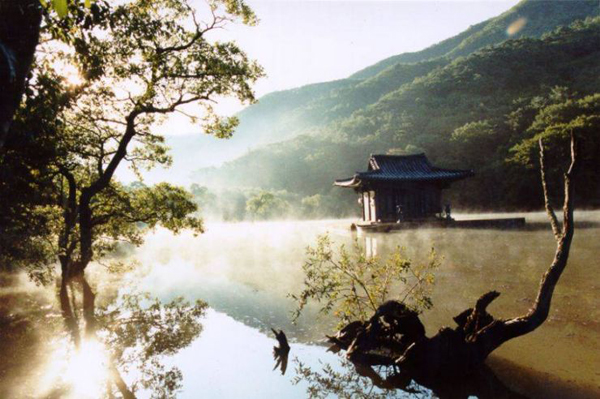
Spring, Summer, Autumn, Winter … and Spring.
Photograph: © Sony Pictures Classics
After tying pebbles to a fish, a frog and a ophidian, the young monk later awakens to find that he himself is fettered by a large shine rock tied to his back. It is the first harsh lesson to be learnt, not through angry chastisement but by redemptive endeavour: the quondam monk calmly instructs the young boy to release the creatures from their suffering, vowing that if any of the animals die, "You will carry the rock in your heart for the rest of your life."
Indeed, the first Noble Truth—the nature of suffering—is a grave precept to have on lath at such an early on historic period, made all the more poignant by the weeping of the boy when he discovers that although the frog has managed to survive, both the fish and ophidian have perished, signalling a portentous omen of that which is withal to come.
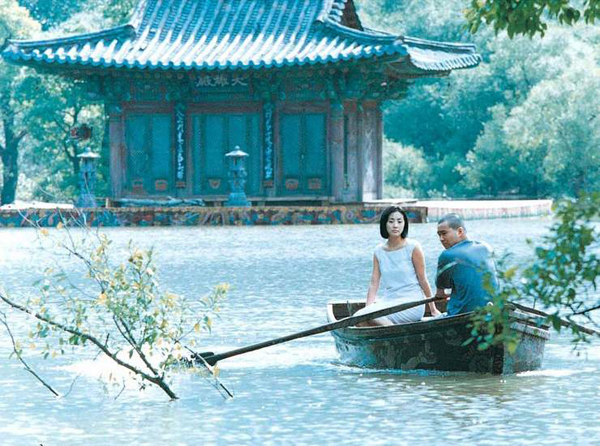
Leap, Summertime, Autumn, Wintertime … and Leap.
Photograph: © Sony Pictures Classics
So, in emptiness, no class,
No feeling, idea or option,
Nor is there consciousness.
No eye, ear, olfactory organ, natural language, torso, listen;
No colour, sound, smell, sense of taste, touch,
Or what the mind takes hold of,
Nor even act of sensing.
—The Heart Sutra
The wooden gates open again, this fourth dimension on the season of summer. The young novice is now a teenager (Seo Jae-kyung), moderately proficient at keeping the Buddhist rituals of the temple in place. Soon, however, the tranquillity of the hermetic abode is disturbed past the inflow of a young woman, affected with an unspecified malady. The master allows her to stay in gild to restore her concrete and mental forcefulness, noting calmly, "When she finds peace in her soul, her body will return to wellness."
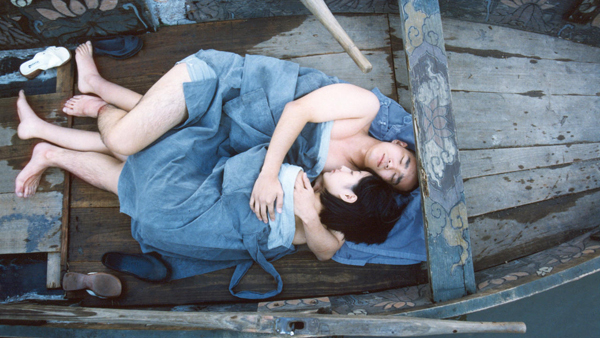
Bound, Summer, Fall, Winter … and Spring
Photograph: © Sony Pictures Classics
Needless to say, the young adult female awakens sexual desire in the student, with their playful flirtations culminating in passionate lovemaking amidst shoreside rocks and the hull of the chief's rowboat. Upon discovering their hugger-mugger tryst, the sometime monk is, withal, unmoved and simply observes, "Animalism leads to want for possession, and possession leads to murder," again foreshadowing later events. He then dispatches the young woman, now healed, dorsum to her mother. The pupil is devastated and, forsaking his monastery home, follows subsequently her leaving his eremitic life behind.
The lush and arcadian environment where nature is in its fullest blossom has seeped deep into the soul of the student, stimulating the innate need for consummation and animalism. Indeed, the master acknowledges the inevitability of his protégé's actions by stating wrily it is only natural for him to succumb; without the full realization of the Buddha'southward teachings, the cause of our pain and anguish, as the second Noble Truth wisely informs usa, is unfettered peckish and desire.
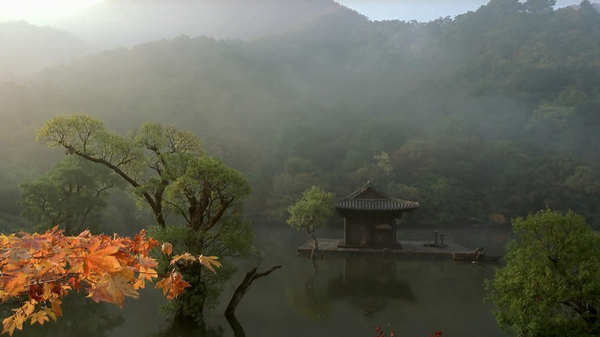
Spring, Summer, Autumn, Wintertime … and Bound
Photo: © Sony Pictures Classics
No ignorance or stop of it,
Nor all that comes of ignorance;
No withering, no decease,
No finish of them.
—The Middle Sutra
The wooden threshold now reveals the arrival of fall. The old monk has considerably anile and all the same his modest life is as it ever was. Returning from a trip to replenish nutrient supplies, past chance, the master notices devastating news nearly his one-time student reported in the local newspaper. Anticipating his imminent arrival, the student returns, now a thirty-year-old fugitive (Kim Youg-min), on the run from a violent crime he has recently committed.
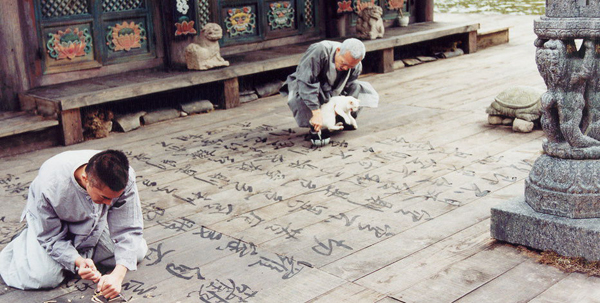
Bound, Summer, Autumn, Winter … and Leap
Photo: © Sony Pictures Classics
In an act of penance, the student attempts suicide simply his master beats him brutally earlier writing out the Heart Sutra (Prajnaparamitahrdaya or The Centre of the Perfection of Wisdom) on the monastery deck, using his cat'due south tail every bit a calligraphy brush. When he finishes, he commands the young monk: "Cleave out all of these characters and while y'all are etching, anger will be cut out of your middle." Every bit the disciple's rage dissipates through the painstaking transcription, 2 policemen arrive to arrest the young monk and carry him away to his fate.
Again, the onetime monk is left alone to reflect upon the purpose of life. His duty towards his former pupil is now completed for he understands that even the pursuit of wisdom itself is rooted in emptiness. He builds a funeral pyre in the rowboat and, covering his ears, eyes, nose and oral fissure with paper in the style of the traditional Buddhist death ritual, is engulfed by flames every bit the gunkhole drifts slowly across the lake, the scene endmost with a snake slithering forth the hermitage deck.
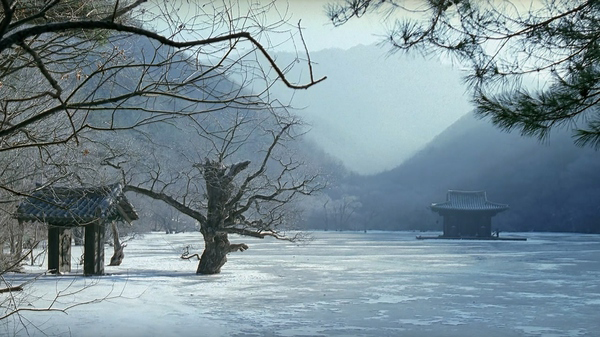
Bound, Summer, Autumn, Wintertime … and Spring
Photograph: © Sony Pictures Classics
Nor is there hurting, or crusade of pain,
Or end in pain, or noble path
To lead from pain;
Not fifty-fifty wisdom to attain!
Attainment besides is emptiness.
—The Heart Sutra
The creaking of the wooden doors now reveals winter has descended upon the secluded monastery, long since abandoned and frozen in ice. Again, the student returns (as the manager himself, Kim Ki-duk), this time on parole as a mature man in eye age. Coming to the realization that his love instructor has left the temporal world, he excavates his main's charred remains from the icy corpse of the rowboat, placing them on the altar, and and then embarks upon a new life of prayer, meditation and qigong.
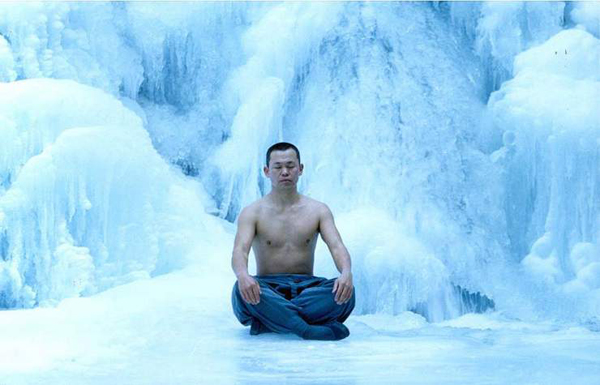
Leap, Summer, Autumn, Winter … and Leap.
Photo: © Sony Pictures Classics
The monk's spiritual journeying is finally coming to an cease as the last 2 of the Buddha'due south Noble Truths are now realized through penance and disciplined adherence to the steps of the Eightfold Path. And thus, in a pilgrimage of atonement for the aggregating of all the suffering in his center, both unwittingly and wittingly enacted, the monk takes out a statue of Guan Yin, and so attaches a millstone to his body with a rope and drags information technology to the top of a mountain, whereupon he sits in meditation, looking downward on his floating hermitage and reflecting upon the unending cycles of human existence.
It is not before long that a veiled woman appears, bearing an infant, whom she entrusts in the intendance of the monk. Slipping away in the dead of night, the young female parent slips on the frozen pond's surface and falls down a pigsty, only to exist discovered the following morning time trapped lifeless under the ice.
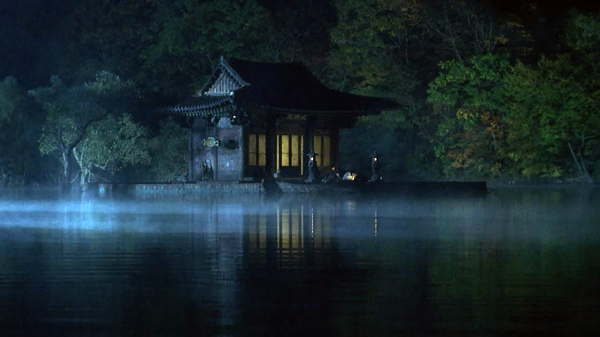
Spring, Summer, Autumn, Winter … and Spring.
Photograph: © Sony Pictures Classics
So know that the Bodhisattva
Property to nothing whatever,
Just dwelling in Prajna wisdom,
Is freed of delusive hindrance,
Rid of the fearfulness bred past it,
And reaches clearest Nirvana.
—The Heart Sutra
The wooden threshold opens ane final time on a beautiful jump day. The babe is now a young boy and the former student is now master to his new charge. The student is seen tormenting a turtle, harking back to the capriciousness of his predecessor at the beginning of the tale and the egoic seed of zipper and devastation impregnated within in all beings, preparing u.s.a. yet again for the cycle of life to get-go anew …
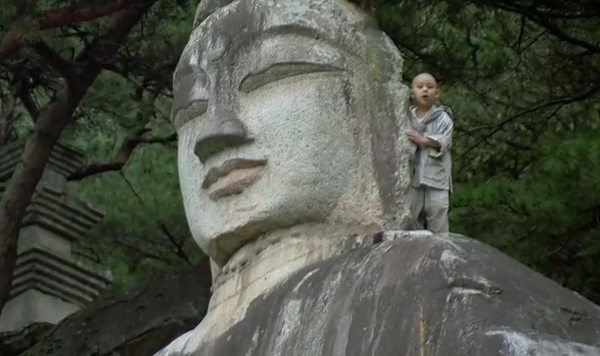
Spring, Summertime, Autumn, Winter … and Leap.
Photograph: © Sony Pictures Classics
Thus the circumvolve of life repeats itself again—nature rejuvenates herself every four seasons, homo reincarnates himself through the lifespan of every man and yet everything remains exactly as information technology was, is, and shall forever exist. As the film fades into emptiness, for several moments afterwards we feel the ambient sounds of the natural world—the tinkling of the wind chinkle, birdsong, the lapping of water against the rowboat—continuing to resonate deep inside united states of america, instilling reverence for the sacredness of nature and sublimity of the empty void.
Exquisitely scored and shot with each frame exuding the composition of a painting, Bound, Summer, Autumn, Winter… and Bound transmits a transcendental dazzler all of its own, elevating the soul with its elegant and timeless aesthetic from innocence, through love and evil, to enlightenment and finally rebirth, subtlely and silently observed past the impassive gaze of a bodhisattva.
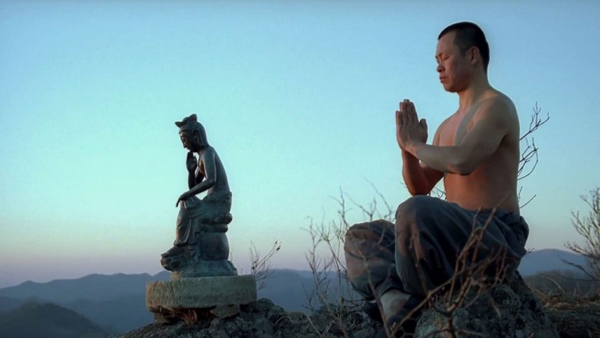
Jump, Summer, Fall, Winter … and Spring.
Photograph: © Sony Pictures Classics
All Buddhas of past and present,
Buddhas of future time,
Using this Prajna wisdom,
Come to total and perfect vision.Hear then the cracking dharani,
The radiant peerless mantra,
The Prajnaparamita
Whose words abate all pain;
Hear and believe its truth!Gate Gate Paragate Parasamgate
Bodhi Svaha
Gate Gate Paragate Parasamgate
Bodhi Svaha
Gate Gate Paragate Parasamgate
Bodhi Svaha
—The Centre Sutra
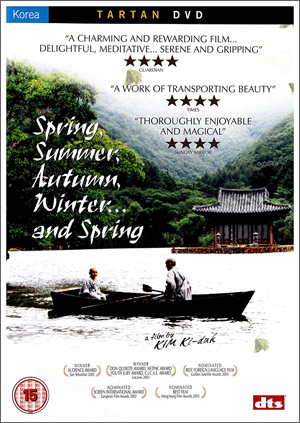
Buy DVD
Post Notes
- Michelangelo Frammartino: Le Quattro Volte
- Pavel Lungin: The Island
- Alan Watts: Cloud-Subconscious, Whereabouts Unknown
- Apichatpong Weerasethakul: Uncle Boonmee Who Can Recall His By Lives
- Philip Gröning: Into Great Silence
- Edward A. Burger: Amidst White Clouds
- Paula Marvelly: The Monasteries of Meteora
- Lao Tzu: Tao Te Ching
Join Our Newsletter
Source: https://www.theculturium.com/kim-ki-duk-spring-summer-autumn-winter-and-spring/
0 Response to "Spring Summer Fall Winter and Spring Again Einstein Notion of Time"
Post a Comment